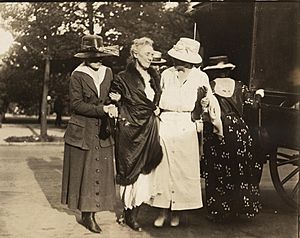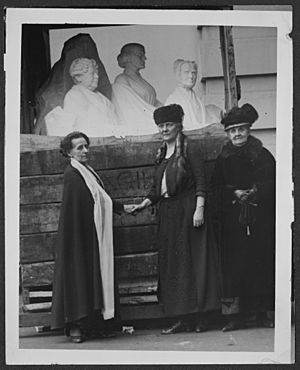Dora Lewis facts for kids
Quick facts for kids
Dora Kelly Lewis
|
|
|---|---|
 |
|
| Born |
Dora Kelly
October 13, 1862 |
| Died | January 31, 1928 (aged 65) |
| Nationality | American |
| Known for | Suffragist |
| Relatives | Howard Atwood Kelly (brother) |
Dora Lewis (born October 13, 1862 – died January 31, 1928) was an important American suffragist. A suffragist is someone who worked to get women the right to vote. She was also known as Mrs. Lawrence Lewis.
Dora Lewis was active in the National American Woman Suffrage Association. Later, she helped start the National Woman's Party. She took part in the Silent Sentinels protest. This protest helped push for women's right to vote.
Contents
Joining the National Woman's Party
In 1913, Dora Lewis became an early leader in the National Woman's Party (NWP). She was a very active member of this group. She was arrested many times for speaking up for women's voting rights.
For example, in July 1917, she spent three days in jail. This was for picketing, which means protesting outside a building. She was arrested again in November 1917. After this, she was sent to a workhouse for 60 days.
Dora Lewis was also arrested in August 1918. This happened at a meeting in Lafayette Square. She was the main speaker there. She was sentenced to 15 days in jail. In January 1919, she was arrested during "watchfire" protests. She had started these by burning copies of President Wilson's speeches. For this, she was sentenced to five days.
The Night of Terror
On November 14, 1917, a difficult event happened. It became known as the "Night of Terror". This took place at the Occoquan Workhouse. The leader there ordered guards to treat the suffragists harshly. Dora Lewis was among these women.
Guards pushed her into a dark cell. They hit her head against an iron bed. This made her lose consciousness. Her cellmate, Alice Cosu, thought Dora Lewis had died. Alice Cosu then became very ill. Other women were also treated roughly by the guards.
Newspapers shared stories about how the protesters were being treated. While at Occoquan, Dora Lewis went on a hunger strike. This means she refused to eat.
Continuing the Fight for Voting Rights
Even after facing such harsh treatment, Dora Lewis kept working for women's suffrage. The Nineteenth Amendment was a big step. It gave women the right to vote across the United States.
After it passed Congress, Dora Lewis traveled to different states. She visited places like Georgia, Kentucky, and Delaware. She wanted to encourage these states to approve the amendment. She had some success in her efforts.
In 1918, Lewis became the head of finance for the NWP. In 1919, she became their national treasurer. By 1920, she led their committee for approving the amendment. In 1921, she was photographed at a new suffragist memorial. This memorial was created by Adelaide Johnson and placed in the capitol building.
About Dora Lewis's Life
Dora Lewis grew up in a well-known family in Pennsylvania. She was married and often called Mrs. Lawrence Lewis. Her personal papers are kept at the Historical Society of Pennsylvania. They are known as the Dora Kelly Lewis Correspondence Collection 2137.



